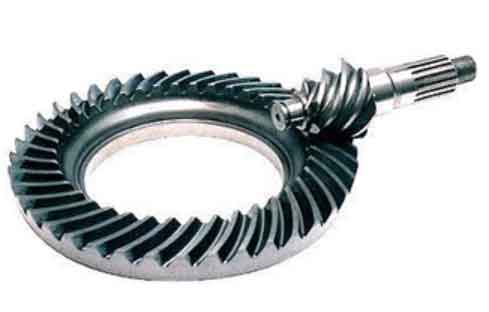Hypoid gears are a type of gears commonly used in wind turbine gearboxes due to their ability to transmit high torque and handle misalignment. They are particularly suited for the low-speed, high-torque requirements of wind turbine applications.

In wind turbines, the primary function of the gearbox is to increase the rotational speed of the slow-moving rotor to a higher speed suitable for generating electricity. The rotor of a wind turbine typically rotates at a low speed, while the generator requires a higher rotational speed to produce electricity efficiently. The gearbox facilitates this speed conversion.
Here’s how hypoid gears contribute to power generation and gearbox efficiency in wind turbines:
- Torque Transmission: Hypoid gears are designed to handle high torque transmission, making them well-suited for wind turbine applications. As wind blows against the rotor blades, it exerts a force that needs to be transmitted efficiently to the generator. Hypoid gears can handle this torque effectively, ensuring smooth power transmission from the rotor to the generator.
- Misalignment Compensation: Wind turbines are subject to various dynamic loads, including wind gusts and turbulence, which can cause misalignment between the rotor and the generator. Hypoid gears have an offset pinion axis, which allows them to accommodate misalignment better than other gear types. This flexibility helps in maintaining proper gear meshing and reduces the impact of misalignment on the gearbox performance.
- Compact Design: Hypoid gears have a compact design compared to other gear types, which is beneficial for wind turbines where space is often limited. The compactness of the gearbox allows for a more streamlined and efficient design of the overall wind turbine system.
- Noise Reduction: Another advantage of hypoid gears is their ability to operate with reduced noise levels. The unique tooth geometry of hypoid gears reduces noise and vibration, resulting in a quieter operation compared to other gear types. This is particularly important for wind turbines installed near residential areas, as it helps minimize noise pollution.
In terms of gearbox efficiency, the design and quality of the gears, including hypoid gears, play a crucial role. Efficient gears, along with proper lubrication and maintenance, can help minimize power losses due to friction and increase the overall efficiency of the gearbox. Additionally, the improved misalignment compensation of hypoid gears reduces the strain on the gearbox components, leading to better efficiency and reliability.
It’s worth noting that the wind turbine industry is constantly evolving, and there may be other gear technologies and designs being developed and implemented to further enhance power generation and gearbox efficiency.
